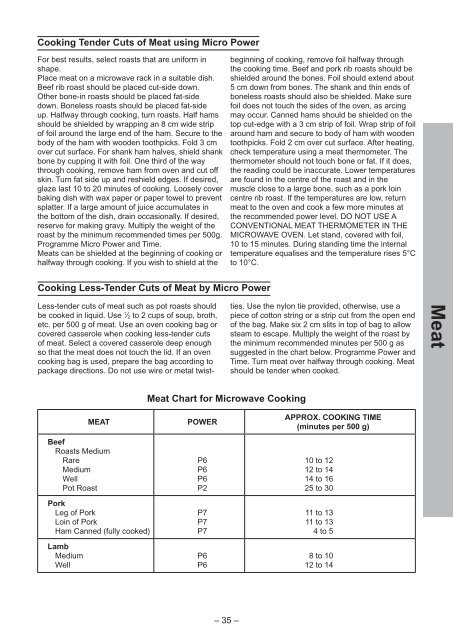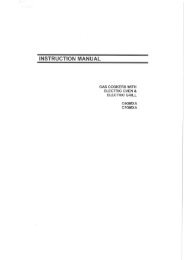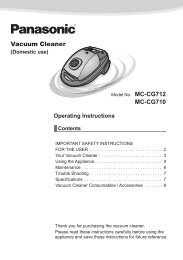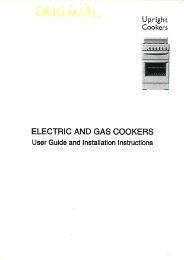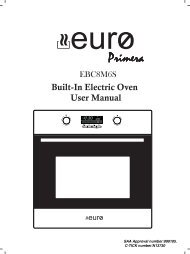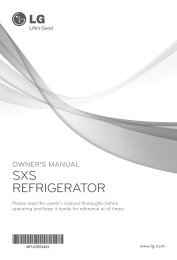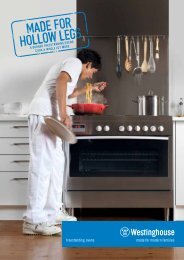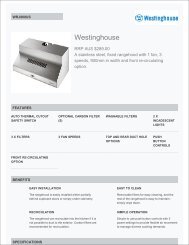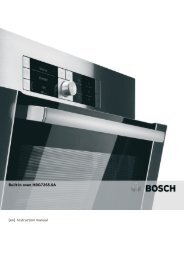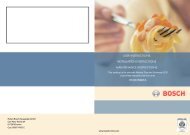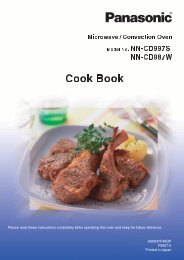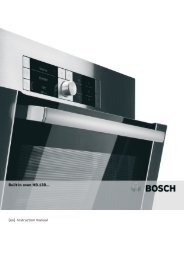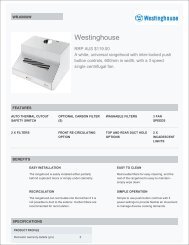Panasonic NN-ST671S 32Litre Microwave User Manual Download
Panasonic NN-ST671S 32Litre Microwave User Manual Download
Panasonic NN-ST671S 32Litre Microwave User Manual Download
You also want an ePaper? Increase the reach of your titles
YUMPU automatically turns print PDFs into web optimized ePapers that Google loves.
Cooking Tender Cuts of Meat using Micro Power<br />
For best results, select roasts that are uniform in<br />
shape.<br />
Place meat on a microwave rack in a suitable dish.<br />
Beef rib roast should be placed cut-side down.<br />
Other bone-in roasts should be placed fat-side<br />
down. Boneless roasts should be placed fat-side<br />
up. Halfway through cooking, turn roasts. Half hams<br />
should be shielded by wrapping an 8 cm wide strip<br />
of foil around the large end of the ham. Secure to the<br />
body of the ham with wooden toothpicks. Fold 3 cm<br />
over cut surface. For shank ham halves, shield shank<br />
bone by cupping it with foil. One third of the way<br />
through cooking, remove ham from oven and cut off<br />
skin. Turn fat side up and reshield edges. If desired,<br />
glaze last 10 to 20 minutes of cooking. Loosely cover<br />
baking dish with wax paper or paper towel to prevent<br />
splatter. If a large amount of juice accumulates in<br />
the bottom of the dish, drain occasionally. If desired,<br />
reserve for making gravy. Multiply the weight of the<br />
roast by the minimum recommended times per 500g.<br />
Programme Micro Power and Time.<br />
Meats can be shielded at the beginning of cooking or<br />
halfway through cooking. If you wish to shield at the<br />
beginning of cooking, remove foil halfway through<br />
the cooking time. Beef and pork rib roasts should be<br />
shielded around the bones. Foil should extend about<br />
5 cm down from bones. The shank and thin ends of<br />
boneless roasts should also be shielded. Make sure<br />
foil does not touch the sides of the oven, as arcing<br />
may occur. Canned hams should be shielded on the<br />
top cut-edge with a 3 cm strip of foil. Wrap strip of foil<br />
around ham and secure to body of ham with wooden<br />
toothpicks. Fold 2 cm over cut surface. After heating,<br />
check temperature using a meat thermometer. The<br />
thermometer should not touch bone or fat. If it does,<br />
the reading could be inaccurate. Lower temperatures<br />
are found in the centre of the roast and in the<br />
muscle close to a large bone, such as a pork loin<br />
centre rib roast. If the temperatures are low, return<br />
meat to the oven and cook a few more minutes at<br />
the recommended power level. DO NOT USE A<br />
CONVENTIONAL MEAT THERMOMETER IN THE<br />
MICROWAVE OVEN. Let stand, covered with foil,<br />
10 to 15 minutes. During standing time the internal<br />
temperature equalises and the temperature rises 5°C<br />
to 10°C.<br />
Cooking Less-Tender Cuts of Meat by Micro Power<br />
Less-tender cuts of meat such as pot roasts should<br />
be cooked in liquid. Use 1 ⁄2 to 2 cups of soup, broth,<br />
etc. per 500 g of meat. Use an oven cooking bag or<br />
covered casserole when cooking less-tender cuts<br />
of meat. Select a covered casserole deep enough<br />
so that the meat does not touch the lid. If an oven<br />
cooking bag is used, prepare the bag according to<br />
package directions. Do not use wire or metal twistties.<br />
Use the nylon tie provided, otherwise, use a<br />
piece of cotton string or a strip cut from the open end<br />
of the bag. Make six 2 cm slits in top of bag to allow<br />
steam to escape. Multiply the weight of the roast by<br />
the minimum recommended minutes per 500 g as<br />
suggested in the chart below. Programme Power and<br />
Time. Turn meat over halfway through cooking. Meat<br />
should be tender when cooked.<br />
Meat<br />
Meat Chart for <strong>Microwave</strong> Cooking<br />
MEAT<br />
Beef<br />
Roasts Medium<br />
Rare<br />
Medium<br />
Well<br />
Pot Roast<br />
Pork<br />
Leg of Pork<br />
Loin of Pork<br />
Ham Canned (fully cooked)<br />
Lamb<br />
Medium<br />
Well<br />
POWER<br />
P6<br />
P6<br />
P6<br />
P2<br />
P7<br />
P7<br />
P7<br />
P6<br />
P6<br />
APPROX. COOKING TIME<br />
(minutes per 500 g)<br />
10 to 12<br />
12 to 14<br />
14 to 16<br />
25 to 30<br />
11 to 13<br />
11 to 13<br />
4 to 5<br />
8 to 10<br />
12 to 14<br />
– 35 –


